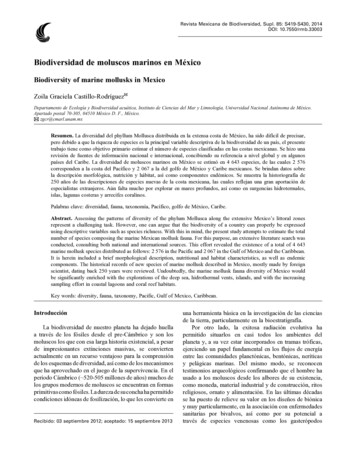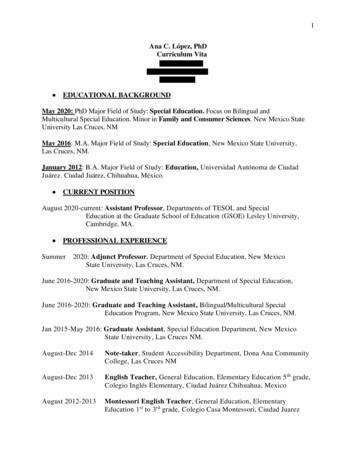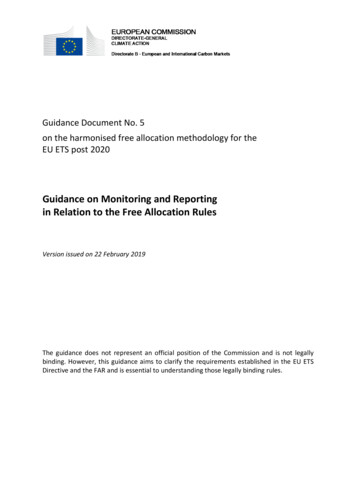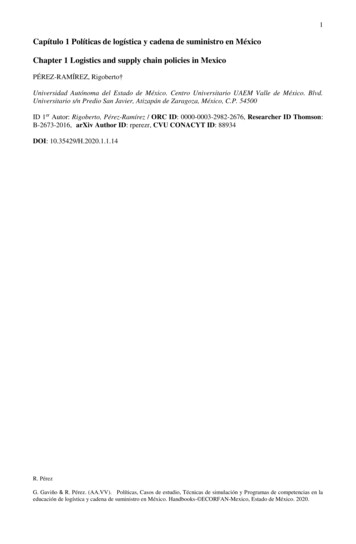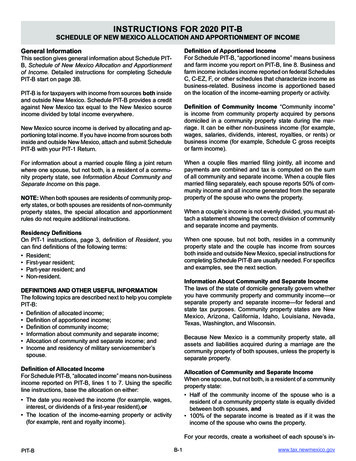
Transcription
INSTRUCTIONS FOR 2020 PIT-BSCHEDULE OF NEW MEXICO ALLOCATION AND APPORTIONMENT OF INCOMEGeneral InformationDefinition of Apportioned IncomeFor Schedule PIT-B, “apportioned income” means businessand farm income you report on PIT-B, line 8. Business andfarm income includes income reported on federal SchedulesC, C-EZ, F, or other schedules that characterize income asbusiness-related. Business income is apportioned basedon the location of the income-earning property or activity.This section gives general information about Schedule PITB, Schedule of New Mexico Allocation and Apportionmentof Income. Detailed instructions for completing SchedulePIT-B start on page 3B.PIT-B is for taxpayers with income from sources both insideand outside New Mexico. Schedule PIT-B provides a creditagainst New Mexico tax equal to the New Mexico sourceincome divided by total income everywhere.Definition of Community Income “Community income”is income from community property acquired by personsdomiciled in a community property state during the marriage. It can be either non-business income (for example,wages, salaries, dividends, interest, royalties, or rents) orbusiness income (for example, Schedule C gross receiptsor farm income).New Mexico source income is derived by allocating and apportioning total income. If you have income from sources bothinside and outside New Mexico, attach and submit SchedulePIT-B with your PIT-1 Return.When a couple files married filing jointly, all income andpayments are combined and tax is computed on the sumof all community and separate income. When a couple filesmarried filing separately, each spouse reports 50% of community income and all income generated from the separateproperty of the spouse who owns the property.For information about a married couple filing a joint returnwhere one spouse, but not both, is a resident of a community property state, see Information About Community andSeparate Income on this page.NOTE: When both spouses are residents of community property states, or both spouses are residents of non-communityproperty states, the special allocation and apportionmentrules do not require additional instructions.When a couple’s income is not evenly divided, you must attach a statement showing the correct division of communityand separate income and payments.Residency DefinitionsOn PIT-1 instructions, page 3, definition of Resident, youcan find definitions of the following terms: Resident; First-year resident; Part-year resident; and Non-resident.When one spouse, but not both, resides in a communityproperty state and the couple has income from sourcesboth inside and outside New Mexico, special instructions forcompleting Schedule PIT-B are usually needed. For specificsand examples, see the next section.Information About Community and Separate IncomeThe laws of the state of domicile generally govern whetheryou have community property and community income—orseparate property and separate income—for federal andstate tax purposes. Community property states are NewMexico, Arizona, California, Idaho, Louisiana, Nevada,Texas, Washington, and Wisconsin.DEFINITIONS AND OTHER USEFUL INFORMATIONThe following topics are described next to help you completePIT-B: Definition of allocated income; Definition of apportioned income; Definition of community income; Information about community and separate income; Allocation of community and separate income; and Income and residency of military servicemember’sspouse.Because New Mexico is a community property state, allassets and liabilities acquired during a marriage are thecommunity property of both spouses, unless the property isseparate property.Definition of Allocated IncomeFor Schedule PIT-B, “allocated income” means non-businessincome reported on PIT-B, lines 1 to 7. Using the specificline instructions, base the allocation on either:Allocation of Community and Separate IncomeWhen one spouse, but not both, is a resident of a communityproperty state: Half of the community income of the spouse who is aresident of a community property state is equally dividedbetween both spouses, and 100% of the separate income is treated as if it was theincome of the spouse who owns the property. The date you received the income (for example, wages,interest, or dividends of a first-year resident),or The location of the income-earning property or activity(for example, rent and royalty income).For your records, create a worksheet of each spouse’s inPIT-BB-1www.tax.newmexico.gov
come. Divide the community income equally between eachspouse and assign 100% of separate income to the spousewho owns the separate property.For general guidance in determining whether income is community income or separate income, see Publication FYI-310,Community Property, Divorce, Separation, and Your NewMexico Income Tax and Internal Revenue Service (IRS)Publication 555, Community Property.Then determine the New Mexico residency status of eachspouse. Based on each spouse’s New Mexico residencystatus, and using the line instructions, determine the correctallocation and apportionment rules to apply to the type ofincome for each spouse.Publication FYI-310 is available at www.tax.newmexico.gov.At the top, click FORMS & PUBLICATIONS, then select FYIsfrom the Publications folder. Open the 300 Series- IncomeTaxes folder to access FYI-310. Publication 555 is availableon the IRS website at www.irs.gov.Example 1. A New Mexico full-year resident and a Coloradoresident (non-resident of New Mexico) are married and file ajoint return. The New Mexico resident has wage income fromemployment in Texas. Because New Mexico is a communityproperty state and the resident spouse is domiciled in NewMexico, the resident spouse’s wage income is communityproperty. Half the wage income from employment in Texasis the property of each spouse.Income and Residency of Military Servicemember’sSpouseThese instructions are effective beginning with tax year 2018.They apply to a military servicemember’s spouse who movesto a state solely to be with the servicemember who is in thatstate due to military orders.The instructions for PIT-B, line 1, require that half of the NewMexico resident’s wage income is allocated in full to NewMexico, even if the income was not earned in New Mexico.The non-resident spouse’s share of the community wageincome is not allocated to New Mexico, because the incomeis not from services performed in New Mexico.They may source their non-military wages, salaries, tips andother income from services performed to their chosen stateof domicile instead of the state where the income is earned.For tax purposes, this can be either the domicile state thatthe servicemember claims or the state in which the servicemember’s spouse has established domicile.Example 2. Use the same facts as example 1, except thewage income is the separate income of the New Mexicoresident spouse due to a separation agreement. All wageincome is allocated to New Mexico, because the spouseentitled to the benefit of the entire amount of wage incomeis a resident of New Mexico.The following restrictions apply to the servicemember andspouse: The servicemember must have declared a “domicile forpurposes of withholding state income taxes from militarypay” in their state of domicile. The servicemember must be in the new state due to military orders. The servicemember’s spouse must be in the new statesolely to be with the military spouse.The New Mexico resident must allocate this wage incomeaccording to the line instructions for a resident taxpayer onPIT-B, line 1.IMPORTANT: The servicemember continues to allocate nonmilitary income from services performed to the state wherethe income was earned.Example 3. Again, use the same facts as example 1, exceptwages from employment in Texas were earned by the nonresident spouse who was domiciled in Texas. Because thenon-resident spouse is domiciled in a community propertystate, the wage income is community property.If you are a New Mexico resident who is a qualifying servicemember’s spouse living in another state, do both ofthe following:When both spouses are residents of community propertystates or both spouses are residents of non-communityproperty states, special allocation and apportionment rulesare not needed. Complete a New Mexico PIT-1 Return as a resident taxpayer. Allocate wages, salaries, tips, and other income from services performed as if they were earned in New Mexico,even though you earned the income in another state.Half of the community income is allocated to New Mexico,based on the instructions for the resident spouse’s shareof the community income. The other half of the communityincome is not allocated to New Mexico, based on the instructions for the non-resident spouse’s share of the communityincome.For details, see Form RPD-41348, Guidance for New MexicoResident Military Spouses Claiming Relief From AnotherState’s Income and Withholding Tax Requirements on theDepartment website at www.tax.newmexico.gov. At the top,click FORMS & PUBLICATIONS then select the followingitems in this order: Income Taxes, Personal Income Tax (PIT) - Current Year, Other PIT-Related Forms, then RPD-41348 Guidance for New Mexico Resident MilitaryExample 4. If both spouses are residents of New Mexico,all community wage income is allocated to New Mexico.More Information about Community and Separate IncomePIT-BB-2www.tax.newmexico.gov
6. If you have an entry on line 8, column 1, complete theworksheet on PIT-B, page 2 unless the entry on line 8,column 2 is the same as column 1 or is zero. Line instructions for the worksheet begin on page 8B.7. Check your figures on PIT-B and, if applicable, the worksheet. Make sure the arithmetic is correct, and that youlimited your entries when required.Spouses Claiming Relief From Another State’s Incomeand Withholding Tax RequirementsIf you are a non-resident of New Mexico who is a qualifyingservicemember’s spouse living in New Mexico, do all of thefollowing: Complete a New Mexico PIT-1 as a non-resident taxpayer. Allocate income from services performed in New Mexicoto the state of legal residency. Mark the box at the top of PIT-B to indicate status asprimary taxpayer or spouse, and qualification for reliefunder the Military Spouse Residency Relief Act.IMPORTANT: Remember that residents must allocateincome and deductions on lines 1, 2, 3, and 7 in full toNew Mexico.8. Do a final check on these parts of PIT-B: Is your correct name and social security numbershown? Is page 1 and, if applicable, page 2 complete? Have you answered all required questions?9. Do a final check on these lines of PIT-B and PIT-1:If you are a part-year or first-year New Mexico resident, whois a qualifying servicemember’s spouse, allocate income fromservices performed in New Mexico to New Mexico duringperiods when you were a resident of New Mexico. You correctly transferred your tax liability from PIT-B,line 14, to PIT-1, line 18. You entered B in the PIT-1, line 18a box to indicateyou used PIT‑B to compute your tax.If you are a military servicemember’s spouse, eligible toclaim an exempt New Mexico withholding status based onthe Military Spouse Residency Relief Act, you must annuallysubmit Form RPD-41348 to your employer or payor responsible for withholding New Mexico tax. Keep a copy, signed bythe employer or payor, in your records. Do not submit RPD41348 with your PIT-1 unless the Department requests it.COMPLETING THE TOP OF PAGE 1Enter the taxpayer’s first name, middle initial, last name, andsocial security number exactly as they appear on the PIT-1.Residency PeriodPart-year and first-year residents enter the beginning andending date for the tax year when the taxpayer was a residentof New Mexico. If married filing jointly, and your spouse’sresidency period is different, enter the period of residency foryour spouse. If additional periods of residency apply, writethem on PIT-B in the space below the lines.Your employer or payor must sign a new RPD-41348 annually, or when your situation changes.How to Prepare the PIT-BYou can find out more about preparing your PIT-B, in thenext sections: Overview; Completing the Top of Page 1; About Line Instructions and columns; Line Instructions for Page 1; and Instructions for Page 2 Worksheet.Qualifying Military Servicemember’s SpouseIf either the primary taxpayer or spouse is a qualifying militaryservicemember’s spouse (see Income and Residency of Military Servicemember’s Spouse, page 2B), is not a resident ofNew Mexico, and is allocating income earned from servicesperformed in New Mexico to the state of residence, at thetop of PIT-B mark box E (Taxpayer) or F (Spouse).OVERVIEWFollow these steps to prepare and complete Schedule PIT-B:1. On PIT-1 instructions, page 19, read Important Guidelines.2. Before beginning PIT-B, complete your federal return andyour New Mexico PIT-1 through line 17.3. Gather any additional forms or publications you need.For helpful resources, see PIT-1 instructions, page 1,Contacting the Department.4. Collect any additional tax records to show the sources ofyour income items. Some taxpayers find it helpful to makea list identifying the source of each income item reportedfor federal income tax purposes.5. Fill in your PIT-B using the line instructions that begin on the next page. Specific instructions for lines1, 2, 3, and 7 apply to column 2 for different residency statuses. Follow the instructions for the residency status you reported on PIT-1, boxes 1e and 2e.IMPORTANT: Marking box E or F is required to indicatequalification for relief under the Military Spouse ResidencyRelief Act.ABOUT LINE INSTRUCTIONS AND COLUMNSThese instructions are intended to make it easier for you tocomplete the PIT-B. No instructions are given for lines thattell you to add, subtract, or perform similar actions.Each line instruction describes the allocation and apportionment rules for the type of income.References to Line Numbers on Federal FormsLine number references to federal forms are for your convenience. They are based on information available to theDepartment at the time these instructions go to print.NOTE: You can find definitions for resident, first-yearresident, part-year resident, and non-resident on PIT-1instructions, beginning on page 2, Who Must File.PIT-BB-3www.tax.newmexico.gov
Completing the ColumnsFirst complete column 1. You can usually take the amountfrom your federal return.does not include partial days.If your taxable wages and other compensation include moving expenses, the compensation is taxable to New Mexicoonly if the move is made from another state into New Mexico.Column 2 and Residency StatusBecause many amounts you enter in column 2 are determined by your residency status, make sure to use thecorrect residency status instructions. If you are filing a jointreturn, use the residency status instructions for you andyour spouse.Non-resident military and non-resident U.S. PublicHealth Service members wages or salary. Exclude fromline 1, columns 1 and 2, any military wages or salary earnedby a non-resident servicemember that was: Also included in federal adjusted gross income, and Reported on PIT-1, line 9.New Mexico residency status is defined on PIT-1 instructions,page 3. You report your residency status on PIT-1, page 1,lines 1e and 2e.If you changed your domicile or residency to, or from, NewMexico during the tax year, exclude only the military salaryor wages earned while a non-resident of New Mexico. If anyor all non-resident wages or salaries were for active dutymilitary service in the U.S. Armed Forces or U.S. PublicHealth Service, that amount is also included in the amountyou deducted from your New Mexico taxable income onSchedule PIT-ADJ, lines 16 and 21 respectively.LINE INSTRUCTIONS FOR PAGE 1Detailed instructions for each line are given here, along withspecific information about columns.LINE 1. Wages, salaries, tips, etc.To calculate the credit for taxes paid to another state, seepage 27 of the 2020 PIT‑1 instructions for line 20.Non-resident servicemember’s non-military wages orsalary. Include in line 1, columns 1 and 2, all non-militarywages or salary earned from services performed in NewMexico.Column 1Enter the amount of wages, salaries, tips, etc. from federalForm 1040 or 1040SR, line 1.Column 2Resident. Enter the same amount you entered in column 1.Qualifying non-resident military servicemember’sspouse. A qualifying non-resident military servicemember’sspouse who has a signed Form RPD-41348, Military SpouseWithholding Tax Exemption Statement, may allocate incomeearned from services performed in New Mexico to the stateof residence by excluding the income in column 2. For details about military servicemember’s spouse, see page 2B.Residents of New Mexico must allocate in full to New Mexicoall amounts of wages, salaries, tips, etc. on PIT-B, line 1,column 1. If the income was earned outside New Mexico andtax was paid to the other state on that income, residents mayclaim a non-refundable credit for the tax paid to the otherstate on that income.Qualifying resident military service member’s spouse.A qualifying New Mexico resident military servicemember’sspouse may allocate income earned in another state to NewMexico by including the income in column 2.First-year resident. Enter all wages, salaries, tips, etc.earned inside and outside New Mexico after date in whichNew Mexico residency was established.If you are a first-year resident or part-year resident whois a qualifying military servicemember’s spouse, you mayallocate income earned from services performed in anotherstate to New Mexico during the part of the year you were aresident by including the income in column 2. During thepart of the year you were a non-resident, allocate incomeearned in another state from services performed in that otherstate by excluding it from PIT-B, line 1, column 2.Part-year resident. Enter all wages, salaries, tips, etc. earnedinside and outside New Mexico during the part of the year youwere a resident of New Mexico.Non-resident. Enter all wages, salaries, tips, etc. earnedinside New Mexico or that came from services performedin New Mexico.Payment for annual leave, sick leave, and holiday leaveassociated with employment or services performed in NewMexico is New Mexico income.LINE 1a. If you used Form PIT-110, Adjustments to NewMexico Income, in the calculation of line 1, column 2, markthe box.Non-residents who work regularly in New Mexico but temporarily assigned to duty outside New Mexico* may use thePIT-110 Worksheet, Adjustment to New Mexico Income. Youcan get this worksheet from the Department website or fromany Department office.LINE 2. Interest and dividendsColumn 1To calculate interest and dividends, follow these steps:1. Start with the amount of federal taxable interest on line 2b,and dividends on line 3b of federal Form 1040 or 1040SR.NOTE: “Temporarily assigned to duty outside New Mexico”PIT-BB-4www.tax.newmexico.gov
2. If you have municipal bond income, subtract the NewMexico tax-exempt interest and dividends reported onPIT-ADJ, line 6, from the amount of federal tax-exemptdividends and interest reported on PIT-ADJ, line 1.3. Add the amounts from steps 1 and 2.4. Enter the result in line 2, column 1. Pension and annuity amounts you received after establishing residence in New Mexico, plus The ordinary income portion of any lump-sum distributionfrom federal Form 4972 you earned the right to receivewhile a New Mexico resident.Part-year resident. Add the following and enter the total: The portion of pensions and annuities you received whileyou were a resident of New Mexico, plus The ordinary income portion of any lump-sum distributionfrom federal Form 4972 you earned the right to receivewhile a New Mexico resident.Column 2Resident. Enter the same amount you entered in column 1.Residents. New Mexico residents must allocate in full toNew Mexico all amounts of interest and dividends on PIT-B,line 2, column 1. If you are a resident and you paid tax onthat income to another state, you may claim a non-refundablecredit for the tax paid to the other state on that income. Tocalculate the credit for taxes paid to another state, see page28 of the 2020 PIT‑1 instructions for line 20.Non-resident. Enter zero. Pension and annuity income of anon-resident are not allocated to New Mexico.NOTE: Effective for retirement income received after December 31, 1995, federal law prohibits any state from imposing anincome tax on certain retirement income (primarily pensionincome) of an individual unless that person is a resident ofor domiciled in the state imposing the tax.First-year resident. Enter the amount of interest anddividends you received after establishing your residence inNew Mexico. To determine when you received interest anddividends, use the date they were payable.For example, if you receive a pension from your former California employer, but you established your domicile in NewMexico, California may not impose its income tax on thatretirement income. New Mexico may impose its income taxon your retirement income, because you are a New Mexicoresident.Part-year resident. Enter the amount of interest anddividends you received while a resident of New Mexico. Todetermine when you received interest and dividends, usethe date they were payable.Non-resident. If you are a non-resident with no commercialdomicile [commercial domicile defined here as the principalplace where you direct or manage a trade or business] inNew Mexico, enter zero. If you operate a business with acommercial domicile in New Mexico, allocate to New Mexicoany non-business interest and dividend income from yourNew Mexico operations.LINE 4. Rents and royaltiesAll taxpayers with income from real property (including rentsand royalties from oil and gas interests), tangible personalproperty, or intangibles located or used in New Mexico mustallocate and apportion the income or loss based on the location of the income-earning property. Intangibles are listednext and definitions for the use of copyrights and patentsfollow, along with an example.LINE 3. Pensions, annuities, social security, and lumpsum distributionsIntangibles are the following: Copyrights; Patents; Franchises; Trademarks; and Licenses.Column 1From your federal Form 1040 or 1040SR return, enter thetotal amount of taxable IRA distributions on line 4b, taxablepensions and annuities on line 5b, and taxable social securityon line 6b. Include ordinary income and lump-sum distributions on line 11, as reported on federal Form 4972, Tax onLump-Sum Distributions.Copyright. A copyright is used in New Mexico when printingor other production takes place in New Mexico.Column 2Resident. Enter the same amount you entered in column 1.Patent. A patent is used in New Mexico when it is employed inproduction, fabrication, manufacturing, or other processing inNew Mexico or when a patented product is produced in NewMexico.Residents. New Mexico residents must allocate in full toNew Mexico all amounts of pensions, annuities, social security, and lump-sum distributions on PIT-B, line 3, column1. If you are a resident and you paid tax on that income toanother state, you may claim a non-refundable credit forthe tax paid to the other state on that income. To calculatethe credit for taxes paid to another state, see page 27 of the2020 PIT‑1 instructions for line 20.EXAMPLE. If rental property is located in New Mexico,include the income on PIT-B, line 4, column 2.If you report income from real property, tangible personalproperty, or intangibles on federal Schedule C or similarbusiness income schedules, show that income on PIT-B,First-year resident. Add the following and enter the total:PIT-BB-5www.tax.newmexico.gov
line 8, not line 4.What to do in special cases. If you cannot determine thelocation of the tangible personal property during the rental orroyalty period, enter the rental or royalty income from thosein New Mexico to whom the property was delivered. On line4, column 2, enter the total rental or royalty income for thetangible personal property shown in line 4, column 1.Column 1Enter the net amount of rents and royalties from your federalSchedule E.Column 2All taxpayers. Start with the net amount of rents and royalties from all of the following New Mexico sources:If you are a resident of New Mexico, or if the business deriving the income has a commercial domicile in New Mexico,you may come across these situations: Rents from real property located in New Mexico Rents from tangible personal property located or used inNew Mexico Income from royalties and working interests in oil and gasproducing properties located in New Mexico Income from patents, copyrights, franchises, trademarks,and licenses used in New Mexico The basis for earnings from intangibles used in New Mexico and elsewhere does not permit allocation to a definitestate. The accounting procedures do not clearly show the stateor states where the intangible was used.In either of these situations, enter the total income from allintangibles.In addition to these sources, residents allocate income fromintangible and tangible personal property used in anotherstate if the New Mexico resident is not subject to tax on theincome in the other state. First-year residents and partyear residents allocate the income described above to NewMexico if the income was earned during a part of the yearthat the individual was a resident of New Mexico.LINE 5. Gains or losses from the sale or exchange ofpropertyColumn 1Enter the net amount of gains or losses from the saleor exchange of property from your federal Schedule 1.All taxpayers with income from the sale or exchange ofproperty allocate and apportion the income or loss on line 5,column 1, based on the location of the income-earning property or activity. If a gain is realized on the sale of real propertylocated in New Mexico, include the income in column 2.Allocating rental or royalty income on tangible personalproperty. If you do not know the extent to which tangiblepersonal property was used in New Mexico, follow thesesteps to calculate the entry for line 4, column 2:1. Find these numbers to use in your calculation: Number of days the property was physically located inNew Mexico during the rental or royalty period Number of days the property was physically locatedeverywhere during the rental or royalty period Total amount of rents and royalties received for thetax year2. Divide the days in New Mexico by the days everywhere. Thisgives you the percentage of time the property was locatedin New Mexico.3. Multiply the total rents and royalties received for the taxyear by the percentage in step 2.4. Enter the step 3 result on line 4, column 2.Column 2All Taxpayers. Enter the net amount of a gain or loss fromthe sale or exchange of any of the following: Real property located in New Mexico; Tangible personal property located in New Mexico atthe time of sale; Tangible personal property located in another state atthe time of sale, if the taxpayer is a New Mexico residentor part-year resident (see the residency definitions in PIT1 instructions); Tangible personal property of a business located inanother state at the time of sale when the taxpayer isnot subject to tax in that state, the taxpayer’s commercialdomicile is in New Mexico, and the income is not subjectto apportionment on line 8; and Intangible personal property, if the taxpayer is a NewMexico resident, part-year resident, or has a commercialdomicile in New Mexico, and the income is not subject toapportionment on line 8.EXAMPLE. An out-of-state taxpayer rents a drilling rig toa New Mexico taxpayer. The drilling rig is in New Mexicofor 90 days. The rig is rented for a total of 270 days duringthe tax year in several states. The total rents and royaltieseverywhere are 25,000,000. The calculation for the line 4,column 2 entry is shown next.90 days located in NM 270 total days everywhere 33.3% percent of time in NM x 25,000,000 rents/royalties everywhereLINE 6. Income or losses from pass-through entitiesUse line 6 to allocate and apportion to New Mexico incomeor losses from pass-through entities and trusts. Allocate distributions of ordinary income (losses) to partners, membersor owners of partnerships, limited liability companies, andSub-Chapter S corporations, based on where the incomeproducing activities occur.The result is the rent and royalty income allocable to NewMexico. Enter this amount on line 4, column 2.PIT-BB-6www.tax.newmexico.gov
NOTE: If you paid tax to another state on any of your otherincome, you may claim a non-refundable credit for the taxpaid to the other state on that income. To calculate the creditfor taxes paid to another state, see page 27 of the 2020 PIT‑1instructions for line 20.Distributions of ordinary income or losses to partners, members, or owners of partnerships, limited liability companies,and Sub-Chapter S corporations are allocated on PIT-B, line6, based on where the income producing activities occur.Distributions of other non-business income is allocated onthe remainder of PIT-B, based on the type of income and theresidency status of the partner, member, or owner.First-year resident. Enter all other income earned from NewMexico sources before establishing New Mexico residency,and all other income earned, regardless of source, afterestablishing New Mexico residency.NOTE: Federal Schedules E and K-1 may include incomefrom both business and non-business sources. New Mexicodoes not have a form equivalent to Schedule K-1. Each partnership, S corporation, estate, trust, or similar pass-throughentity usually provides a statement or report showing thecorrect allocation, apportionment, and distribution of incometo members, partners, shareholders, or beneficiaries fortheir records.Part-year resident. Enter all other income earned, regardless of source, while you were a New Mexico resident, andall other income earned from New Mexico sources.No
If you are a non-resident of New Mexico who is a qualifying servicemember's spouse living in New Mexico, do all of the following: Complete a New Mexico PIT-1 as a non-resident tax-payer. Allocate income from services performed in New Mexico to the state of legal residency. Mark the box at the top of PIT-B to indicate status as
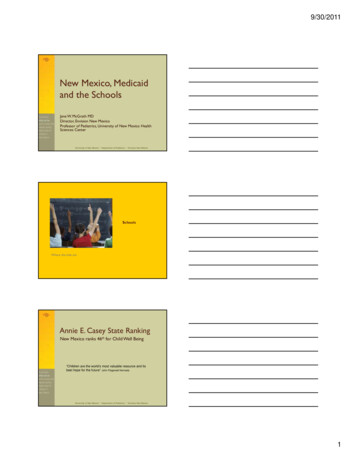


![[Title to come] DSP Dynamic Asset Allocation Fund](/img/24/dsp-dynamic-asset-allocation-fund.jpg)
